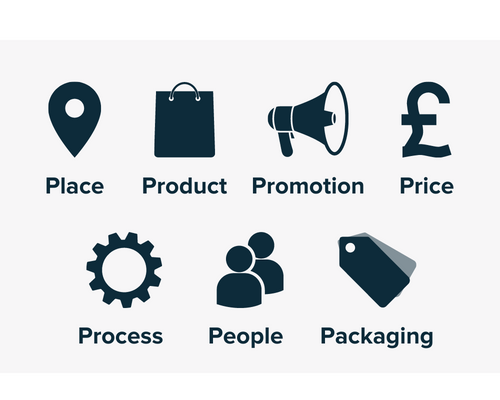Marketing mix elements are a vital part of any marketing strategy and can make or break a company’s ability to sell.
We all know that customer journeys are getting more complicated. As more people get comfortable online and new channels emerge, businesses need to ensure they’re sharing the right message, in the right place, to the right people.
This is where marketing mix elements come into play.
Understanding how these elements work to drive purchasing decisions means marketers can better understand the psychology behind why consumers buy.
In this blog, we’ll go through:
Let’s get started.
The 4 Ps of marketing are a framework for understanding the basic elements that must be considered when marketing a product or service.
The model was first developed in the 1950s by E. Jerome McCarthy, and it has since been refined and updated.
The 4 Ps are:
Each of these factors is important to consider when developing a marketing strategy, and they work together to create a complete picture of how a company will market its product or service.
It’s important to remember that changes in one area can have an effect on other areas – so a well-rounded marketing mix is key.
But remember, the 4 Ps of marketing have been updated and are now the 7 Ps of marketing.
Let’s explore each in more detail.
The 4 Ps of marketing have since been updated to the 7 Ps of marketing. These marketing mix elements are important to consider when you’re building your marketing strategy.

Use them as a solid framework to promote your product or services to your chosen target marketing.
The 7 Ps are:
Let’s go through each one, one a time.
First up is product. If you don’t have a good product, you’re going to struggle to sell or retain customers.
The product is the most important aspect of any marketing mix. It’s the thing that you’re selling, and it’s what your target market wants or needs. The job of a marketer is to define what a product does and its qualities. This includes understanding the product life cycle, which is important to understand, but includes many factors beyond just the product itself.
Prioritise making your product the best it can be and optimise your marketing around it. This is known as product-led marketing.
Product considerations are vital to your marketing success. They include:
You can use all of this to better position your marketing strategy and content.
When considering product, make sure you:
Pricing is unsurprisingly important when it comes to potential customers. When setting prices, marketers need to take into account a variety of factors, including supply costs, competitors’ prices, and retail markup.
Priced too low and you could be considered poor quality, priced too high you could be priced out of the market.
The first thing to do is a competitor analysis of pricing. By understanding where you fit in with your competitors, you can create a pricing strategy that works for you and your product. But most importantly, that works for your customers.
These are some common strategies for businesses looking at their pricing model:
Remember there are a lot of considerations when updating your pricing model. Are you a value or premium brand? Are you winning new business at your desired pricing levels? How is your pricing received?
Understanding the answers to these questions will help you develop a pricing model that suits you and your customers.
Promotion is the part that most people think of when you say the word ‘marketing’. It entails all of the content, campaigns and channels you use on a daily basis.
It’s important to create a demand for your product or service before you can convert consumers into customers. Promotion has the power to influence consumers and get them interested in buying your product or service.
From creating a newsletter to writing a social media post or pushing a TV ad live, promotion can be thought of as the outward push of the business.
The key to succeeding in promotion is understanding your target audience and your product.
What’s your main proposition? The emotional hook that resonates with people?
Finding and creating content around this is how you’ll convert eyes into leads and leads into sales.
Remember, it’s a journey. It’s not a one-off solution. You need to guide your audience from the top of the funnel, all the way down to the bottom.
Related: Full guide to customer journey tracking
Choosing the right channels and prioritising your budget accordingly is key here.
The place where you sell your product or service is an important part of the marketing mix.
It can dictate how much you are able to sell and how efficiently you can do so. There are a few different ways to go about selling products and services, and each company has its own preferences.
You’re best looking at market research to understand where’s best to sell your product. Most businesses will look to sell directly online, others via 3rd party sites, and others might have to close business direct or even face-to-face.
People refers to anyone who might come into contact with your customer, even indirectly. Historically that would have predominantly been sales. But now, that would include marketing and customer service or success.
Understanding people is:
Processes is a pretty broad topic but still so important to get right as part of your marketing mix.
It can include things like, how users receive goods and services, how customer service supports and solves problems, and how refunds are processed and received.
The important thing to remember when it comes to processes is that you want to be customer-centric. Everything should revolve around supporting them. While you want to be cost-effective you also want to provide good high-quality service.
Balancing on this tightrope can be tricky, but when it’s done right can end up being really fruitful.
Physical evidence, sometimes also known as packaging, is how you wrap all of this up in a neat bow.
It’s not just how your product looks, but how your brand works as a whole.
It can include things like:
The goal with physical evidence is to present yourself as an efficient, well-run company set on supporting its customers.
The original Ps of marketing were created in the 50s and while they still stand now they are viewed as a little dated.
It’s generally thought that small businesses selling a more “standard” product can use the 4 Ps without the need for the extra three. Meanwhile for businesses selling specialised services or products, then the 7 Ps are much more desirable.
People, process and physical evidence are all elements much more synonymous with digital marketing and deeper organisational charts where customers engage with sales, marketing and customer success.
Adding these three marketing mix elements should be done where you feel marketing branches out into sales and customer service.
By that we mean, you feel processes need alignment, and that improvement can be made to the overall customer experience.
When using the 7 Ps of marketing mix model, it’s important to be aware of some common pitfalls that can occur.
Here are five key ones to keep in mind:
1. Failing to consider all aspects of the market
The 4 Ps model is just a starting point for creating a marketing mix. Businesses should continue to research their industry and target market to make sure they are including all relevant factors in their strategy.
2. Focusing too narrowly on one aspect of the market
While it’s important to understand each element of the 4Ps, businesses can’t afford to focus exclusively on any one area. Instead, they need to take a holistic approach that considers all elements simultaneously.
3. Neglecting customer feedback
It’s essential to constantly gather feedback from customers in order to gauge their reaction to your product or service and make necessary changes.
4. Not adapting as the market changes
The business landscape is always changing, so companies must continually adapt their marketing strategies accordingly if they want to remain successful
5. Using data to guide your strategy
It’s not a case of creating success once and then maintaining forever. The channels that you use should be dictated by customer feedback and data.
Correlating these two sources of information means you can better serve future customers and better optimise your marketing strategy.
While the 7 Ps are the first step to ensuring you have a solid marketing strategy in place, it’s clear you can’t stop there.
Ensuring your marketing effectiveness is an all-year endeavour and the key to that is data.
Marketing mix modelling is the perfect stepping stone from marketing mix elements.
It allows you to get a greater sense of understanding when it comes to knowing which marketing channels, campaigns and content is working best to drive your bottom line.
Learn more about marketing mix modelling and how you can connect the dots between your sales and marketing.
